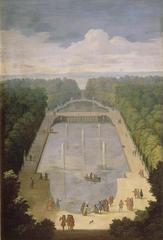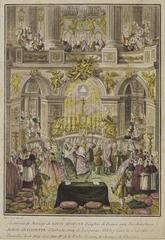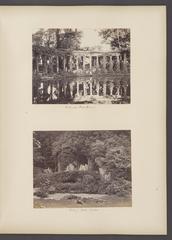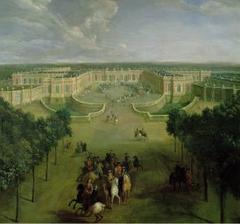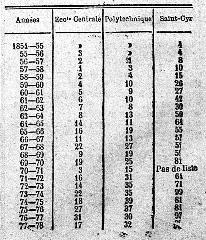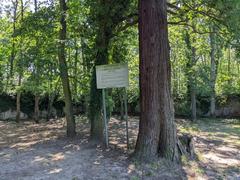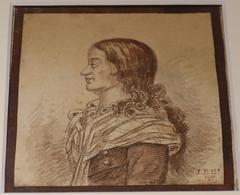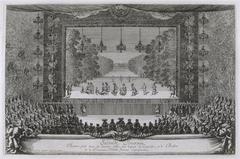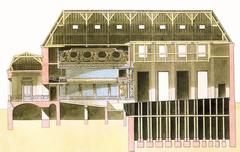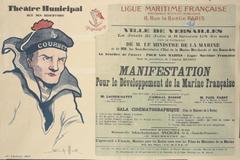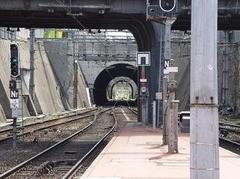
Prison des Chantiers: Visiting Hours, Tickets, and Historical Guide – Versailles, France
Date: 04/07/2025
Introduction: History and Cultural Significance
Situated in the historic city of Versailles, the Prison des Chantiers stands as a powerful testament to France’s turbulent 19th-century political history. Built during a period of rapid urban transition, the prison bore witness to pivotal events such as the Franco-Prussian War and the Paris Commune, notably serving as a detention center for political prisoners including the renowned Communard Louise Michel. Although the original buildings have largely disappeared and the site now hosts the Collège Technique Raymond-Poincaré, the legacy of the prison endures through historical research, exhibitions, and memorialization efforts. For visitors, the Prison des Chantiers offers a unique opportunity to deepen their understanding of French history, social change, and the evolution of the justice system. This guide provides a detailed overview of the prison’s origins, its societal role, practical visitor information, and tips for exploring nearby attractions (Versailles Tourism, Annuaire Prisons, Wikipedia).
Table of Contents
- Introduction
- Origins and Construction
- Role in the Franco-Prussian War and the Paris Commune
- Notable Inmates and Political Repression
- Architecture and Daily Life
- The Prison’s Urban and Social Context
- Legacy and Historical Memory
- Visiting Information: Hours, Tickets, and Accessibility
- Travel Tips and Nearby Attractions
- FAQ
- Conclusion
- Sources and Further Reading
Origins and Construction
The Prison des Chantiers was established in the mid-19th century, adjacent to the Gare des Chantiers railway station, reflecting Versailles’ shift from a royal seat to a modern administrative center. Conceived as a model correctional facility, its layout and construction embodied contemporary penal philosophies prioritizing security, inmate segregation, and surveillance. Over time, the prison adapted its structure and administration to accommodate changing penal reforms and the evolving demographic of inmates, particularly women and political prisoners.
Role During the Franco-Prussian War and Paris Commune
From 1870–1871, Versailles became the seat of the French government in exile during the Franco-Prussian War, and the Prison des Chantiers assumed a new role as a detention center for political prisoners. Thousands of Communards and supporters—many of them women and children—were incarcerated here following the suppression of the Paris Commune. Among the most notable detainees was Louise Michel, whose writings and memoirs provide invaluable first-hand testimony of the period (La Commune de Paris Blog). An iconic 1871 photograph by Ernest Eugène Appert documents the prison and its inmates, capturing a critical moment in French political history.
Notable Inmates and Political Repression
The Prison des Chantiers became a symbol of state power and repression, especially in its treatment of female revolutionaries. Prisoners such as Louise Michel and Eulalie Papavoine endured harsh conditions, with strict surveillance and limited rights, reflecting both the gendered dynamics of 19th-century political persecution and the broader struggle for civil liberties.
Architecture and Daily Life
Originally a religious convent repurposed as a prison, the facility retained elements such as high walls and barred windows. Its architecture enforced isolation and control, while daily routines were rigid and communication strictly regulated. Modernization efforts in the late 20th century introduced updated facilities and security measures, but the historical ambiance remained palpable in its remaining structures (Annuaire Prisons).
The Prison’s Urban and Social Context
Unlike the nearby Palace of Versailles, renowned for its royal grandeur, the Prison des Chantiers represents a different facet of the city’s history—one marked by conflict, governance, and social change. Its proximity to major transportation hubs and integration into the urban landscape underscore its significance in Versailles’ broader historical narrative.
Legacy and Historical Memory
Although the original prison buildings have been demolished and replaced by the Collège Technique Raymond-Poincaré, the site retains its historical resonance. The memory of its role in the Paris Commune and its association with political prisoners is preserved through academic research, memoirs, and occasional guided tours—particularly during heritage events or “parcours communards” commemorations (La Commune de Paris Blog). Visual documentation, such as photographs by Appert, further enriches public understanding.

Visiting Information: Hours, Tickets, and Accessibility
Current Status and Location
- Address: 2, place Poincaré, 78000 Versailles, France
- Current Use: Collège Technique Raymond-Poincaré occupies the site; no original prison buildings remain (Wikipedia).
Visiting Hours and Tickets
- No Official Visiting Hours: The site is not open to the public, as it is now a functioning school. The exterior may be viewed at any time from public streets.
- No Tickets or Entry Fee: There is no charge or ticket required for exterior viewing.
Accessibility
- Mobility: The area around Place Poincaré is flat and accessible, with ramps and elevators available at the nearby Versailles-Chantiers train station.
- Facilities: Public restrooms are available at the train station; cafés and shops are within walking distance.
Travel Tips and Nearby Attractions
- Getting There: The site is adjacent to the Versailles-Chantiers railway station, with direct connections to Paris Gare Montparnasse (30–40 minutes by train). Paid parking is available nearby, though public transportation is recommended.
- Nearby Sights: The Palace of Versailles, Versailles Cathedral, and Potager du Roi are within 2 km, making it easy to combine a visit to the former prison site with other attractions.
- Historical Walks: Some Versailles walking tours include the Chantiers district and its historical sites, particularly those focusing on the Paris Commune or lesser-known city history.
FAQ
Q: Are there official visiting hours for Prison des Chantiers?
A: No. The site is now a school, and only the exterior can be viewed from public streets at any time.
Q: Is there an entry fee or ticket required?
A: No. There is no ticket or fee for exterior viewing.
Q: Is the site accessible for those with mobility impairments?
A: Yes. The area is flat and accessible, with facilities available nearby.
Q: Can I take photographs?
A: Exterior photography is permitted in public areas. Please avoid photographing students or entering school grounds.
Q: Are guided tours available?
A: No regular tours are offered, but local historical societies occasionally include the site in special heritage events.
Conclusion
Though its original structures no longer exist, Prison des Chantiers remains a site of profound historical importance in Versailles. Visitors can engage with its legacy through research, photographs, memoirs, and by respectfully viewing the site’s location. For those seeking to understand Versailles beyond its royal legacy, the story of the Prison des Chantiers provides a compelling glimpse into the city’s political, social, and penal history.
Enhance your exploration of Versailles by combining visits to the city’s renowned landmarks with a reflective stop at this significant historical site. To deepen your understanding, download the Audiala app for audio guides, follow us on social media, and explore our related articles on the Paris Commune and Versailles’ lesser-known sites.
Sources and Further Reading
- Versailles Tourism
- Annuaire Prisons
- Wikipedia: Prison des Chantiers
- La Commune de Paris Blog
- Google Arts & Culture: Prison des Chantiers, le 15 août 1871, Versailles
- Wikimedia Commons: Category Prison des Chantiers
- Wikimedia Commons: Ernest Eugène Appert Photograph
- Metropolitan Museum of Art: Photograph of Prison des Chantiers

















































